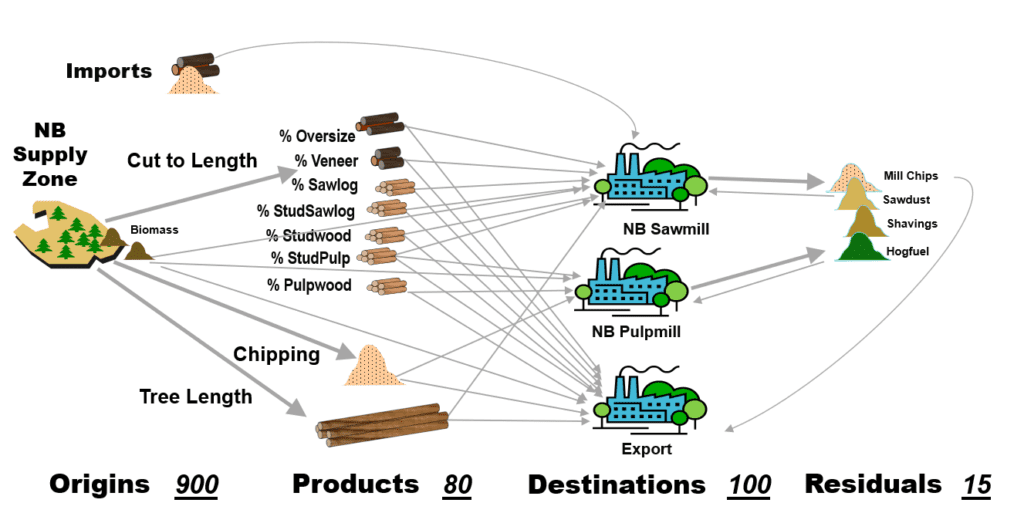The New Brunswick Woodflow Model was designed to contribute to the economic, environmental, and social sustainability of the forests and forest industry in the province. It is a bird’s-eye view of the sector, showing the complex relationships between the stakeholders and sites that support the province’s largest industry.
Since it was created in 2012, the model has been used by multiple stakeholders to analyze and measure options ranging from regional wood supply and demand, the economic efficiency of allocating sustainable wood supplies from all tenures, the impacts of opening new mills or closing existing ones due to market forces, as well as identifying new investment opportunities.
Complex and Valuable Supply Chain
The New Brunswick land base is 7 million hectares (ha), eighty percent of which is forested and home to over twenty commercial tree species. The forest industry is an important economic driver in the province. In 2012, the land base was jointly owned and managed by three major stakeholders – the New Brunswick government (50%), industry (20%) and private landowners (30%). The diverse manufacturing base, wide variety of wood products, and numerous wood sources (including both New Brunswick and neighboring provinces and states) presents an extremely complex and valuable supply chain.
Like most areas with a significant forest industry, New Brunswick has a high demand for fibre. The supply and demand balance is complex, given a limited wood supply and the diverse and changing needs of a restructuring industrial base. Between 2006 and 2012 New Brunswick, like most forest jurisdictions, suffered great losses with as much as 50% of sawmills and pulp and paper mills forced to close. With depressed markets and tight margins, the economic viability of the forest sector came under scrutiny, and the interdependence caused market shifts in wood fibre flow.
In the late 2000s, the New Brunswick government and New Brunswick’s forest sector were facing challenges in managing wood supply and securing new investments. Several high profile Task Force studies examining forestry management and how to improve New Brunswick’s forest economy pointed to the need for a collaboration between the major forest sector stakeholders, and a transparent, fibre balance model to represent the flow of wood fibre in all its forms from sources to users. This would allow important questions such as “What is the economically accessible wood allocation within provincial and external markets?” and “What are the business opportunities with respect to available fibre supply?” to be analyzed.
Decision Support Model for Diverse Stakeholders
Both the government and the forest sector understood the opportunities afforded by modeling and optimization and were seeking an analytical solution that would not only address their immediate questions surrounding woodflows but would also serve as a link between resource and industry. Although they traditionally operate independently, there is a unanimous agreement amongst all New Brunswick forest stakeholders that working collaboratively is vital to ensure healthy and sustainable forests and forestry sectors.
Working with the key stakeholders, Remsoft was asked to develop a decision support model that would address the economics of provincial woodflows, and support the collective or individual needs of all stakeholders. The process was supported by a committee with members from the New Brunswick Department of Natural Resources, New Brunswick Forest Products Association, New Brunswick Federation of Woodlot Owners and License holders.
Building a provincial woodflow model was no easy task given both the scale and complexity of the problem, and the complex and varying interests of the stakeholders. But, after months of discussions, deliberations, data collection and decision-making, the New Brunswick Woodflow Model was born. Used by stakeholders to analyze the provincial supply and demand balance and the economics of woodflows, the model successfully synthesizes the interests of all stakeholders into one model.
New Brunswick Supply Chain and Wood Flow

The New Brunswick Wood Flow Model is a high level, comprehensive provincial model of wood supply and consumption that includes all wood sources and sinks (both domestic and external) capturing delivered wood costs and mill gate prices. The model includes 80 products, 900 supply zones and 100 mills representing upwards of 7 million wood allocation decision variables. The model has the potential to analyze and measure possibilities ranging from regional wood supply and demand, the economic efficiency of Crown wood allocations, investment opportunities for surplus products, as well as the impacts of opening new mills or closing existing mills due to market forces.
Remsoft was able to develop a model that captured the essence of the province’s wood supply and demand balance from an economic, environmental, and socially sustainable perspective.”
Mark Arsenault, President, New Brunswick Forest Products
Wood Supply Model Construction
The software used for the wood supply analysis was Remsoft’s Woodstock Optimization Studio. Woodstock is capable of both forest inventory projection simulation and harvest schedule optimization. Woodstock is also capable of stochastic, Monte-Carlo type simulation which has been used successfully to assess private woodlot wood supply.
The model’s uniqueness lies in its ability to support a variety of interests and in its potential for future innovations to address new or expanded value chain dynamics. In particular, the model serves to address and evaluate strategic business questions in a variety of areas such as:
- Assessing and valuing new business opportunities and the fit within current provincial wood flows
- Understanding the impacts of business change with respect to benefits and costs
- Impacts of fibre allocation decisions (i.e. who gets what wood from where) assessed from a financial perspective
- The value of the resource through calculated stumpage values
- Address senior government and executive level questions allowing for more informed decision making through better understanding of the business challenges
With collaboration across the major forest sector stakeholders, Remsoft developed a model that captured the essence of the province’s wood supply and demand balance from an economic and environmental prospective within one sustainable model. The solution provides provincial forest stakeholders with a holistic decision-making system and the capability to effectively analyze the complexities of the provincial forest value chain.
LEARN MORE:
-
Read our blog post on how optimization techniques like wood basket analysis can help forest companies adapt to changing dynamics.
-
Learn more about Remsoft’s Woodstock Optimization Studio.



